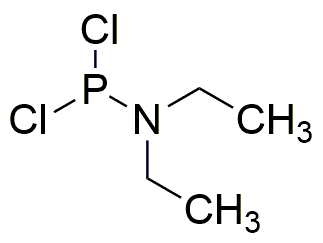Dichloro(diethylamino)phosphine is widely utilized in research focused on:
- Synthesis of Organophosphorus Compounds: This chemical serves as a key intermediate in the production of various organophosphorus compounds, which are crucial in agriculture for developing pesticides and herbicides.
- Pharmaceutical Research: It is employed in the synthesis of phosphine-based drugs, offering potential therapeutic benefits due to its unique reactivity and ability to form stable complexes with metal ions.
- Polymer Chemistry: The compound is used in creating specialty polymers, enhancing properties such as flame resistance and thermal stability, making it valuable in the manufacturing of high-performance materials.
- Chemical Synthesis: It acts as a reagent in various chemical reactions, including nucleophilic substitutions, allowing researchers to develop new compounds with specific functionalities.
- Environmental Applications: The chemical is explored for its potential in environmental remediation processes, particularly in the removal of heavy metals from wastewater, showcasing its utility in sustainable practices.
General Information
Properties
Safety and Regulations
Applications
Dichloro(diethylamino)phosphine is widely utilized in research focused on:
- Synthesis of Organophosphorus Compounds: This chemical serves as a key intermediate in the production of various organophosphorus compounds, which are crucial in agriculture for developing pesticides and herbicides.
- Pharmaceutical Research: It is employed in the synthesis of phosphine-based drugs, offering potential therapeutic benefits due to its unique reactivity and ability to form stable complexes with metal ions.
- Polymer Chemistry: The compound is used in creating specialty polymers, enhancing properties such as flame resistance and thermal stability, making it valuable in the manufacturing of high-performance materials.
- Chemical Synthesis: It acts as a reagent in various chemical reactions, including nucleophilic substitutions, allowing researchers to develop new compounds with specific functionalities.
- Environmental Applications: The chemical is explored for its potential in environmental remediation processes, particularly in the removal of heavy metals from wastewater, showcasing its utility in sustainable practices.
Documents
Safety Data Sheets (SDS)
The SDS provides comprehensive safety information on handling, storage, and disposal of the product.
Product Specification (PS)
The PS provides a comprehensive breakdown of the product’s properties, including chemical composition, physical state, purity, and storage requirements. It also details acceptable quality ranges and the product's intended applications.
Certificates of Analysis (COA)
Search for Certificates of Analysis (COA) by entering the products Lot Number. Lot and Batch Numbers can be found on a product’s label following the words ‘Lot’ or ‘Batch’.
*Catalog Number
*Lot Number
Certificates Of Origin (COO)
This COO confirms the country where the product was manufactured, and also details the materials and components used in it and whether it is derived from natural, synthetic, or other specific sources. This certificate may be required for customs, trade, and regulatory compliance.
*Catalog Number
*Lot Number
Safety Data Sheets (SDS)
The SDS provides comprehensive safety information on handling, storage, and disposal of the product.
DownloadProduct Specification (PS)
The PS provides a comprehensive breakdown of the product’s properties, including chemical composition, physical state, purity, and storage requirements. It also details acceptable quality ranges and the product's intended applications.
DownloadCertificates of Analysis (COA)
Search for Certificates of Analysis (COA) by entering the products Lot Number. Lot and Batch Numbers can be found on a product’s label following the words ‘Lot’ or ‘Batch’.
*Catalog Number
*Lot Number
Certificates Of Origin (COO)
This COO confirms the country where the product was manufactured, and also details the materials and components used in it and whether it is derived from natural, synthetic, or other specific sources. This certificate may be required for customs, trade, and regulatory compliance.


